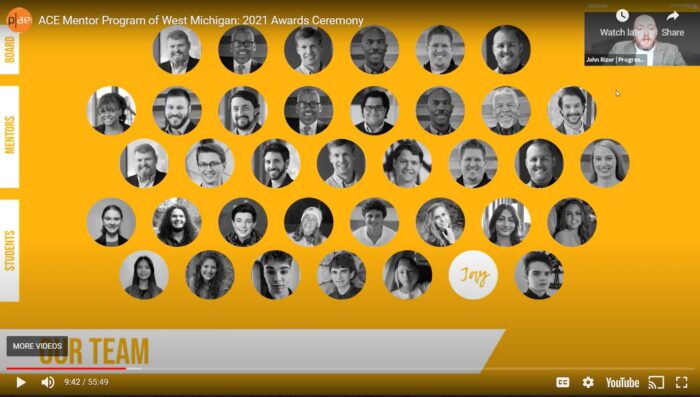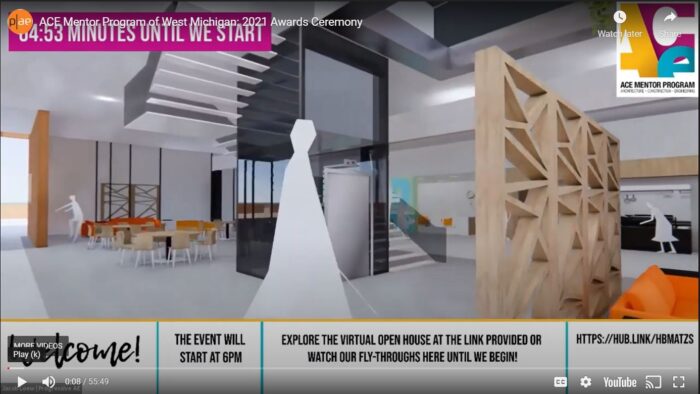


 What’s one of the most dynamic ways to attract young people to careers in the architecture, engineering, construction, and skilled trades industries? Provide them with hands-on experiences that mimic real roles on design projects, and interaction with professionals to mentor and inspire them. That is the mission of the ACE Mentor Program of West Michigan.
What’s one of the most dynamic ways to attract young people to careers in the architecture, engineering, construction, and skilled trades industries? Provide them with hands-on experiences that mimic real roles on design projects, and interaction with professionals to mentor and inspire them. That is the mission of the ACE Mentor Program of West Michigan.
The program is part of the ACE Mentor Program of America, a free, award-winning, after school program designed to expose high school students to career options in the A/E/C industry and related professions. The West Michigan affiliate’s inaugural program wrapped in early March 2020, right before Michigan’s first confirmed COVID cases. The 2020-2021 program was held virtually. The ACE Mentor Program of West Michigan has been supported in part by MAF’s Architecture Awareness Grants.
Architect John Rizor, AIA, CDT, ACE Mentor Program of West Michigan President and an architect at Progressive AE, brought the program to the Grand Rapids area, after being involved with the Chicago affiliate’s successful program. “I saw first-hand what becomes possible when professionals lend their time and expertise to help create opportunity for young people,” said John. “When I moved back to Michigan, it became a passion project for me to establish an ACE Mentor affiliate here.”
Watch this year’s ACE Mentor Program of West Michigan virtual 2021 Awards Ceremony
The national ACE Mentor Program allows each affiliate to design and operate their own program curriculum to fit the needs of its students and mentors. Each year, ACE West Michigan’s program runs for 16 weeks, every Tuesday after school, from October to March.

“The first half of the program is an introduction to the industry,” said John. “Students hear directly from professionals what it means to be an architect, engineer, electrician, construction supervisor, or tradesperson, and their day-to-day responsibilities. The second half is a collaborative design project, where students select their project role – then fulfill the duties of that role, much in the same way professionals work on projects in the real world.”
Students work as a team on the same design project, selected from prompts provided by the Construction Industry Round Table (CIRT), sponsor of ACE Mentor Program’s annual design competition. This year, students chose to design a homeless shelter. “The project taught students the technical side of practice, as well as a better understanding of the social components, empathy and grace that architecture can provide,” said John.
The national ACE Mentor organization offers multiple student scholarships to alumni who have participated in the program for at least two years (scholarships are available for both academic and skilled trade pursuits). Said John, “Students can choose a different role and have a new experience, every time. They also get fresh content and fresh perspectives from participating professionals.”
One of ACE West Michigan’s participating students, Ayesha Jeddy of Forest Hills Central High School in Grand Rapids, was recently awarded a $12,000 national scholarship through the Allen Berg Memorial Scholarship, administered via ACE National. She also was awarded a $2,000 scholarship from Progressive AE.
Many participants plan to pursue related degrees; others are choosing a skilled trades path at schools including Kent County Technical Center. The ACE West Michigan program also awards participants opportunity to apply for two credits at Lawrence Technological University, which are transferrable to most other architecture and engineering schools throughout the country.

All area high school students are welcome, and John says encouraging minority and under-represented students to enroll is a priority. “It is no secret that the A/E/C and skilled trades professions need more female and minority representation,” said John. “It is difficult for students to want to become what they cannot see, and the program gives them real-world exposure to careers, as well as their own potential.” John also has worked with Progressive AE to include the program as part of the firm’s diversity and inclusion initiative.
How does John feel that architecture enriches life? “Architecture is more than the production of buildings – it is also about the role of buildings in the context of community, and how buildings can make people feel included,” he says. “As architects, we have a great opportunity to help people better adapt to the social, economic, and other factors that influence quality of life, by providing better and more equitable built environments.”